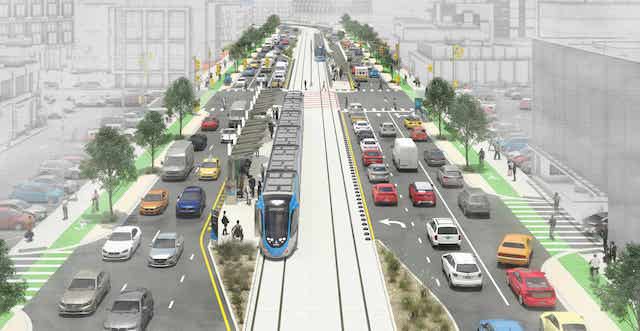The Antiplanner has previously written that light rail should be called lie rail because everything its advocates say about it is a lie. The latest proof comes from Capital Metro, Austin’s transit agency, which now admits that light-rail projects voters approved in 2020 are going to cost at least 78 percent more than originally projected.
Capital Metro persuaded voters to support light rail by claiming it would reduce congestion when in fact it will make it worse by taking lanes away from autos and dedicating them to empty tracks carrying empty light-rail trains.
The original projection, of course, was one of many lies told about the project. Almost every light-rail project ever built has cost far more than the original projections, overruns so systematic that Oxford researcher Bent Flyvbjerg says they are “best explained by strategic misrepresentation, that is, lying.” Other lies included overestimated ridership numbers and the claim that light rail is “high-capacity transit.”
The news report on the Capital Metro cost increase claims that “it won’t affect taxpayers,” but that’s just one more lie. In fact, what Capital Metro said was “that there will be no additional tax increase to support this program.” In other words, Capital Metro won’t raise taxes above the rate approved in 2020, but it will charge that rate for many more years to pay for the rail construction. Construction may also be delayed as the agency waits for sufficient funds to pay for it. Both of those changes from the original proposal affect taxpayers.
Austin transit ridership in February was only 51.6 percent of pre-pandemic levels. It seems practically certain that light-rail will open in Austin after years of planning and construction only to find that it is carrying almost no passengers who weren’t previously riding a bus — and very few of those.









This cost increase is shocking even for those of us who expect cost increases.
The 4.19 mile tunnel is now projected to cost $4.1 billion. Nearly $1 billion per mile.
The two light rail lines were originally estimated at $5.8 billion, now the revised estimate is $10.3 billion.
This is a new low in light rail insanity.
Here is another report
https://www.kxan.com/news/local/austin/project-connect-light-rails-will-likely-cost-10-3b-twice-as-much-as-planned/
The tunnel reminds me that Nashville dodged a bullet when they rejected their transit rail w/ big tunnel plan a few years back.
How long before that’s on the ballot again? 5 years?
Light rails problems are it had no confirmed identity. It was conceived in the 70s and 80s as an economical alternative to heavy rail like metro and subways. Because they were st street level, no tunnels or elevated sections were needed to be built.. As the decades progressed…..they became as expensive as the original trains they were supposed to be superior to.
Another aspect of light that makes lightrail a failure is its defined purpose.
Cities where rail make sense have huge job concentrations. With New York the only one with a million jobs….Chicago snd DC is 1/4 to 1/5th of that. And accommodating job sectors requires several hundred annex points which requires many lines to be built. Lighvrail exists to further growth and projection of more light rail…
As a residential mover system its equally useless. Many light rails often link to neighborhoods and tourist attractions and a few population mass centers like sports stadiums and civic centers. Because train lengths are determined by city block size it can only move 20,000 people an hour. Also it doesn’t connect to but a few daily usage centers like grocery or shopping.
Light rail is billed as excellent for commuting. But compared to commuter trains in Europe are pathetic. Real commuter trains can go 70-100 mph. Light rail seldom goes 40.
So light rail is largely paradoxical…. it’s not effective urban rail because it’ds not a heavy job connector. Irs not a good daily rider because it carries too few and seldom connects to daily locations. And it’s a terrible commuter train because it’s slower than watching snails fuk